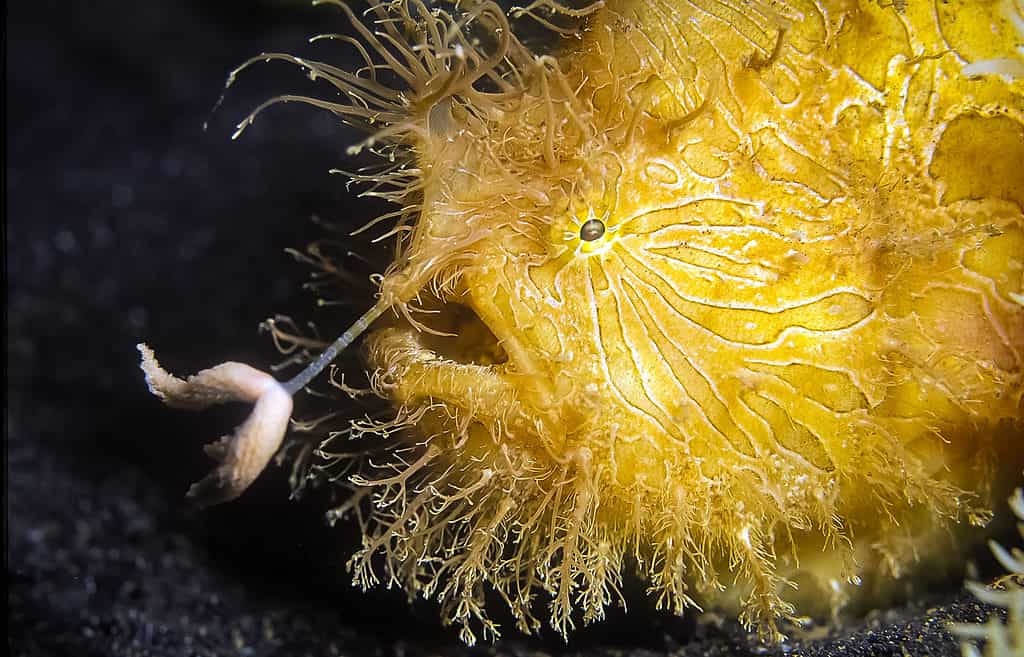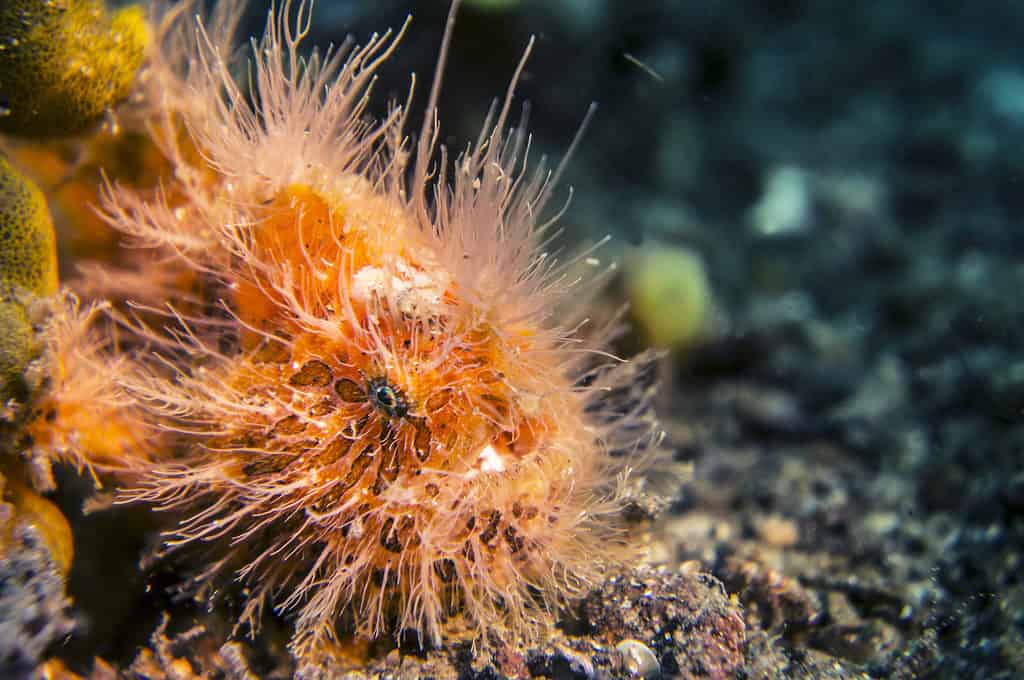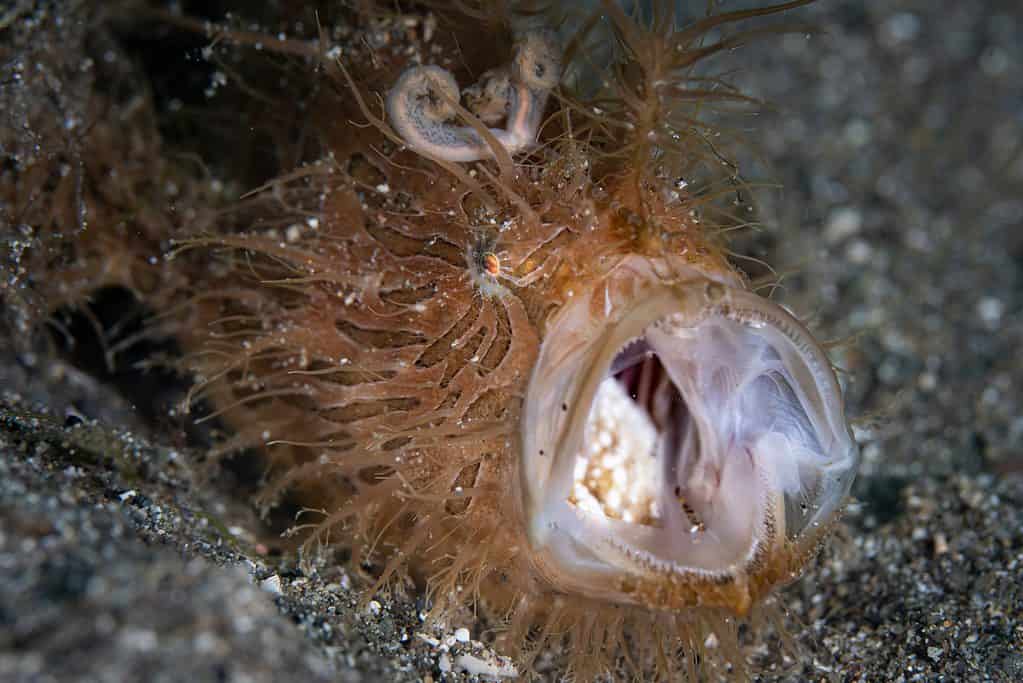Hairy Frogfish
Antennarius striatus
Hairy frogfish can eat prey as large as themselves by swallowing them whole.
Advertisement
Hairy Frogfish Scientific Classification
- Kingdom
- Animalia
- Phylum
- Chordata
- Class
- Actinopterygii
- Order
- Lophiiformes
- Family
- Antennariidae
- Genus
- Antennarius
- Scientific Name
- Antennarius striatus
Read our Complete Guide to Classification of Animals.
Hairy Frogfish Conservation Status
Hairy Frogfish Facts
- Prey
- Small fish
- Group Behavior
- Solitary
- Fun Fact
- Hairy frogfish can eat prey as large as themselves by swallowing them whole.
- Biggest Threat
- Habitat loss and pollution
- Most Distinctive Feature
- Dorsal fin with fleshy lure
- Distinctive Feature
- Angled fins, unique colors and patterns
- Average Spawn Size
- up to 180,000
- Habitat
- Rocky areas, coral reefs
- Predators
- Lizardfish, scorpionfish
- Diet
- Carnivore
- Type
- Fish
- Common Name
- Hairy frogfish
- Special Features
- Wide mouths, mimicry
- Location
- Atlantic, Pacific, Indian oceans
View all of the Hairy Frogfish images!
The hairy frogfish (Antennarius striatus), also known as the striated frogfish, is a species of anglerfish found in tropical and subtropical waters throughout every body of water except for the Arctic and the Mediterranean Sea. They inhabit rocky areas and coral reefs, where they use mimicry and camouflage to blend with their environments. This fish species does not swim like most. Instead, it uses its specialized fins to “hop” across the sea floor. Find out everything there is to know about the fascinating hairy frogfish!
5 Amazing Hairy Frogfish Facts
- Hairy frogfish can eat prey as large as themselves by swallowing them whole.
- They feature angled fins that allow them to “walk” or “hop” along the ocean floor. And they can also travel by expelling water through their gills.
- They use cryptic coloration to mimic coral and sponges, blending with their environment.
- Their color changes within a few weeks after moving to a new location.
- Frogfish are voracious eaters, consuming anything small enough that comes near their mouths.

The hairy frogfish (
Antennarius striatus) has an unusual dorsal fin that they use as a lure, tipping it forward like a fishing rod to catch prey.
©Jack FotoVerse/Shutterstock.com
Classification and Scientific Name
The hairy frogfish (Antennarius striatus) belongs to the Actinopterygii class in the Lophiiformes order, which encompasses the anglerfish. This order is known for its characteristic luminescent fin. The Antennariidae family consists of frogfishes, and the Antennarius genus comprises 11 species that live at the bottom of shallow waters in tropical and subtropical waters.
Appearance
The hairy frogfish is relatively small, measuring around eight inches long and weighing slightly over one ounce. They have round, smooth bodies covered in irregular spines and large mouths that can extend to swallow prey as large as themselves. Their dominant colors are typically yellow, brown, and orange. However, their coloring varies greatly depending on their environment. And they can change their color and pattern within a few weeks of living in a new habitat. Their markings resemble elongated blotches or parallel stripes.
Like other anglerfishes, the hairy frogfish has a dorsal spine, called an illicium, that tips forward like a fishing rod. The spine’s tip features a lure similar to a worm wiggling on a hook. They also have angled pectoral fins that allow the frogfish to keep a stable position before attacking its prey. Their specialized fins also help them “walk” along the ocean floor. To move quickly through their habitat, they take in water through their mouths and expel it through gills located behind their pectoral fins, giving them jet-like propulsion.

Hairy frogfish have round, smooth bodies covered in irregular spines and are typically yellow, brown, or orange in color.
©iStock.com/Tum3000
Distribution, Population, and Habitat
This species lives in tropical and subtropical water in the Pacific Ocean, Atlantic Ocean, Indian Ocean, the Gulf of Mexico, and the Caribbean Sea. The only waters they do not inhabit are the Arctic and the Mediterranean Sea. They are also absent from the eastern Pacific. They primarily inhabit rocky areas and coral reefs, where you can find them on sand, rocks, and rubble. Hairy frogfish live near the surface and as deep as over 600 feet. However, their average depth occurs at 130 feet. They use cryptic coloration to blend with their environment, often looking like coral and sponges.
Evolution and History
Very few frogfish fossil remains have been discovered. But several species surfaced in 2005 and 2006 from the frogfish family, placing their earliest ancestors between five and 56 million years ago. The hairy frogfish evolved through several modifications to thrive in its environments, such as its angled fins for walking and the dorsal fin used as a prey lure.
Predators and Prey
Hairy frogfish are ravenous carnivores who will eat anything that gets close enough that they can fit into their mouths. Their diet typically includes small fish, but they can swallow prey their own size, including other frogfish. They use their unusual dorsal fin as a lure, combined with a chemical attractant at night to make it visible to prey. And they have one of the fastest eating methods among animals. They lack teeth and use suction to grab their food. The frogfish waits for its prey to get close enough, opens its mouth wide, and inhales creatures within six thousandths of a second.
The hairy frogfish has few natural predators. But some marine species, like lizardfish and scorpionfish, occasionally prey on frogfish. This species is a master in its environment, expressing Batesian mimicry, where it mimics dangerous species, like sea anemones. If that doesn’t deter their predators, they inflate their bodies to prevent creatures from swallowing. Now, that’s thinking outside the box!

The hairy frogfish waits for its prey to get close enough, opens its mouth wide, and inhales creatures within six thousandths of a second.
©Paul Tuazon/Shutterstock.com
Reproduction and Lifespan
Females produce up to 180,000 eggs before mating, and males will nudge their abdomen when it’s time to commence. Both sexes swim to the surface, where the female releases her eggs in a ribbon-like mass of mucus called an epipelagic egg raft. The male fertilizes the eggs, and they remain floating for several days. Once it sinks to the bottom, the embryos are ready to hatch. Hairy frogfish can live up to 20 years. But their average lifespan is unknown.
In Fishing and Cooking
Hairy frogfish are not game fish and not used in cooking due to their unpleasant taste. However, they are used in the aquarium trade.
Threats and Conservation Status
The IUCN lists the hairy frogfish as LC or “least concern.” Due to its extensive range and presence in common environments, this species does not meet the threshold for threatened status. They are not commercially fished but occasionally caught in the Caribbean for use in the aquarium trade. Their other threats include habitat loss and pollution.
Locations:
- Atlantic Ocean
- Pacific Ocean
- Gulf of Mexico
- Caribbean Sea
- Indian Ocean
Related Animals
View all 104 animals that start with HHairy Frogfish FAQs (Frequently Asked Questions)
Are hairy frogfish poisonous?
The hairy frogfish is not poisonous or venomous. They have other means of deterring predators.
What eats the hairy frogfish?
They don’t have many natural predators. But species like lizardfish and scorpionfish will prey on frogfish.
How long do hairy frogfish live?
They can live up to 20 years. However, their average lifespan is unknown.
Where are hairy frogfish found?
The hairy frogfish lives in tropical and subtropical waters in the Atlantic, Pacific, and Indian oceans. You can also find them in the Gulf of Mexico and the Caribbean Sea.
Can you keep a frogfish as a pet?
Hairy frogfish are occasionally captured and used in the aquarium trade. It is possible for these creatures to live a long, healthy life with a specific environment that caters to its needs.
What do hairy frogfish eat?
They typically eat small fish but will consume anything small enough that gets close to their mouths.
Can a hairy frogfish swim?
They can swim in short bursts. But their main mode of travel involves “hopping” along the ocean floor using their angled fins and expelled air through their gills.
Thank you for reading! Have some feedback for us? Contact the AZ Animals editorial team.


















